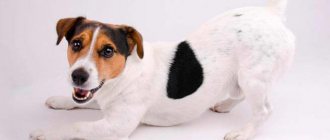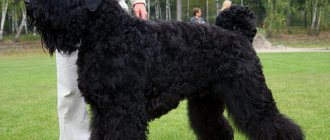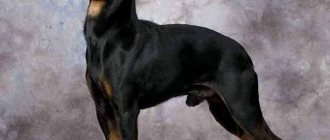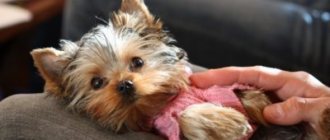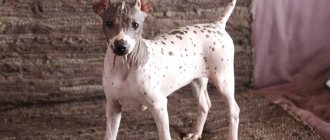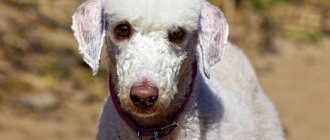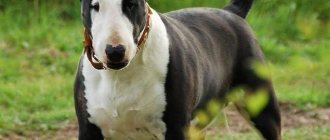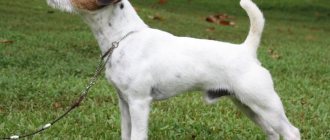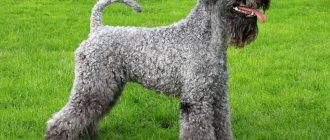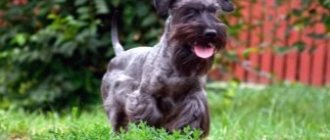Dossier
Adult height: from 20 to 28 cm. Weight: no more than 3 kg. Characteristic color: brown, red, blue and tan. Coat length: longhaired. Life expectancy: up to 18 years. Advantages of the breed: compact, cheerful, loves to spend time in the company of the owner. Difficulties of the breed: susceptible to stress, loves to voice. Average price: up to $200 for a regular puppy; $500 for a puppy with a pedigree. Classification: small breed;
companion dog.
Origin story
The Russian Toy Terrier was bred thanks to the efforts of Moscow dog handlers who tried to restore the number of representatives of the English Toy. However, the dogs used for this were not purebred, so their offspring had slightly different characteristics.
The first livestock of the new breed appeared in Russia in the 50s of the 19th century. The main task of the specialists was to create a completely different group of dogs, which would have its own generally accepted standard, different from the standard of the English breed. This is how the world saw the Russian Longhaired Toy Terrier. This dog has gained popularity very quickly, thanks to their compact size and cute appearance. In 2006, the breed was recognized by the International Canine Association.
Description of the breed
The miniature toy terrier will leave few people indifferent. These fragile and graceful creatures have an expressive, pointed muzzle and large round eyes. Large erect ears are considered an undoubted advantage of the breed, although some compare the toy for them to a bat. Dogs of this breed have thin bones and lean muscles. Long slender legs give the figure grace and sophistication.
The height of an adult dog most often does not exceed 30 cm, and the height to the withers is 25 cm. The dogs are quite thin and light in weight. The weight of the animal rarely exceeds 3 kg. Long-haired Toys have soft, slightly wavy fur of moderate length. It completely covers the animal's body, while emphasizing the contours. The hair on the ears is slightly longer than on the body, it is thick and resembles a fringe.
The Russian Toy Terrier breed standard specifies the following color options:
- black and tan;
- blue and tan;
- brown and tan;
- ginger;
- red and black;
- red with a brown coating.
The scorch marks should not be too dark or have a large area. The presence of white spots on the chest or fingers is considered a fault. Undesirable colors for purebred toys are brown, blue, and black. Judging by the description of the breed standards, puppies that are white in color, as well as those with white spots on the chest, head or neck, or spotting, are subject to culling.
Character
Despite its small size, the Russian Longhaired Toy knows no fear. He is always ready to fiercely defend his master. And when meeting a larger dog, this little one will definitely climb up to it first. You can rest assured that a representative of this breed will always be ready to protect your home from strangers.
When describing the character of the Longhaired Russian Toy Terrier, it is important to note that this breed has a crazy temperament. This is a rather impatient, although very smart dog. She needs constant physical activity to spend her energy in the right direction. She doesn't get along well with children. Noisy companies quickly tire him. He also cannot stand quarrels and scandals in the family.
How to choose a puppy
From the age of one and a half months, long-haired toy terrier puppies are completely ready to move to a new home. At this point, the dog has already been given an identifying mark in the kennel and the necessary vaccinations have been given.
When purchasing, pay attention to the puppy's appearance and character. The baby should be active, cheerful and have a good appetite. Decide on the purpose of purchasing a puppy. Its cost and exterior will depend on this. If you are not taking a dog for breeding, then it does not need a pedigree.
Content Features
Feeding
At first glance, it seems that there will simply be no problems with feeding such a dog. Two spoons are enough to fill you up. However, you need to fit all the essential nutrients into a small portion. Therefore, when choosing a diet, it is very important to follow several important rules.
- The most popular option is to combine natural products with food. However, this must be done extremely carefully, since specialized feeds are created taking into account the correct balance of proteins, fats and carbohydrates. If you add natural products, you risk upsetting this balance.
- If you add natural products to your diet, it should be cereals, soups or meat. You should not give your dog anything spicy, salty or sweet.
- If you feed your toy terrier dry food, you do not need to soak it in water. It performs the function of cleaning teeth.
- Dry food must be chosen very carefully. It should be created specifically for small breeds, since such dogs simply cannot chew large granules.
- Watch your portion sizes. Remember that overfeeding can ruin not only your figure, but also cause problems with the health of your digestive system.
- There is a certain pattern that we advise you to adhere to. The less physical activity, the less food you need to give your pet.
- Make sure your pet always has a supply of drinking water.
- An adult animal needs to be fed twice a day. This can be done a quarter of an hour after walking.
- In order for the nutrition to be balanced, it is necessary to calculate the serving size. Per kilogram of body weight you need 75-80 grams of food.
- If you feed your pet natural food, it must be heated before use.
- Under no circumstances should you suddenly change your diet. In addition, never indulge your Toy Terrier with pieces of food from your table. This can have an extremely detrimental effect on his digestive system.
- We also do not recommend exposing your dog to physical activity immediately after feeding. First he needs to rest a little.
Education and training
The process of raising a toy terrier comes down to knowing the basic commands, his nickname, the ability to go to the toilet and a little socialization. However, this breed can be extremely rebellious. That is why we invite you to familiarize yourself with the basic rules that must be followed when raising and training in order to facilitate these processes.
- The pet should sleep only in a place that is specially designated for it. No concessions for one night.
- You should not allow your pet to growl or show any type of aggression. Such behavior must be punished immediately.
- If you take your dog on a trip, you must place it in a special carrier.
- Train your pet to enter all doors only after you.
- Particular attention should be paid to a female dog, since the mating process and childbirth are very stressful for her.
Walk
This breed simply needs daily walks in the fresh air. They also need physical activity. It is worth paying special attention to the choice of territory for walking, as terriers love to walk in silence and without a leash. Its use may damage the dog's skeleton. This is why you must learn to control your pet in any situation.
Care and maintenance
The Russian Longhaired Toy Terrier is a decorative dog, it is only suitable for keeping in a house or apartment. However, you should immediately accustom your pet to walks outside so that he does not go to the toilet at home. This breed is not litter trained well and will frequently void on furniture or carpets in the future.
When caring for a toy terrier, it is recommended to follow the following rules:
- The Russian Toy Terrier does not require special coat care. It will be enough to brush the dog 1-2 times a week, and you can bathe it after every walk. When bald spots appear, rub burdock oil into your pet's fur.
- Check your toy's ears once a week for dirt, ear infections, or mites.
- Regularly wipe your pet's eyes to prevent accumulated dirt from leading to infection.
- Trim your dog's nails once a month, as long-haired toy terriers are not accustomed to sharpening them themselves.
- In cold weather, be sure to wear special overalls on your dog.
Character and features
Despite its small size, the longhaired toy terrier often tries to show its character and tries to control its owner. This is how the dog wants to attract more attention. She may begin to be capricious when feeding or deliberately mark corners throughout the apartment. Therefore, the owner of a small toy will have to make efforts to teach the pet to obey.
It is necessary from an early age to accustom the toy to peaceful coexistence with other animals. Due to the high likelihood of injury, jumping on furniture and fighting with other pets should be prevented. Before getting such a dog, you need to carefully weigh your options. You will need to spend a lot of time with her.
Upbringing
The small size of a dog can be misleading about how easy it is to train. For all their friendliness, toy terriers do not really like to obey. But if you start raising a dog from the first days of its arrival in the house, you can teach it to adhere to firm rules:
- You can only sleep in a specially designated place;
- the pet should not be allowed to show aggression under any circumstances, stopping such attempts with a sharp command;
- in order to suppress the toy terrier’s natural instinct of leadership, it is necessary to teach the dog to follow the owner and enter after him;
- During travel, the dog must be in a carrier bag.
Dogs of this breed love to bark. They should also be weaned from this habit.
Toy terriers are smart and quick-witted creatures. With persistence, you can teach them to follow all basic commands. Proper upbringing will allow you to enjoy the company of your four-legged friend and avoid problems. The pet needs the owner's love and affection, but one should not overdo it with the manifestation of these feelings.
Nutrition
The Russian Toy Terrier, like most dogs of its size, has a very sensitive digestive system and is prone to overeating. It is necessary to carefully monitor your dog's diet. If you feed your pet natural foods, then most of them should be protein foods. Also, don’t forget about vegetables, fruits, cereals and dairy products.
As for prohibited foods for the toy terrier, these include:
- sweets;
- bakery;
- smoked meats;
- salty food;
- butter and sour cream.
Russian Toy Terrier puppies under the age of 6 months need to be fed 4-3 times a day, and after six months it is worth switching to 2 meals a day.
Choosing the right puppy
To purchase a high-quality representative of the Russian Toy Terrier breed, you need not only to have money, but also at least minimal knowledge about the breed and what you need to pay attention to when choosing a puppy.
The most important point is the conditions in which the dog and puppies are kept. You should immediately refuse the purchase if small terriers live in unsanitary conditions and do not receive the necessary care and nutrition. Like any purebred dog, Toy cannot be bought at the market or in an underground passage. There are great chances to buy not only a sick dog, but even a mongrel.
If the choice of a breeder has been made, then it’s time to move on to an external examination of the puppy. The skin should be clean, free of dandruff, abrasions, and irritation.
Behavior should be active and playful. It is normal for a puppy to become frightened when being held by a stranger.
Then you should look at the veterinary passport; it must be available. By two months the puppy should have one vaccination, by three months - two.
All this information must be displayed in detail in the passport: the date of vaccination, the signature of the veterinarian, certified by a seal.
The cost of a dog largely depends on the class. There are show class, bri class and pet class. Show-class terriers are exhibition representatives of the breed, and their cost is about 70 thousand rubles. Brie-class pets cost half as much.
These dogs meet all breed requirements. But pet-class toys are not allowed for further breeding, as they have a number of disadvantages. However, shortcomings will not prevent them from becoming a beloved, active member of the family.
- The price of puppies is individual in each case and depends on many indicators. It is also worth noting that long-haired dogs are much more expensive.
Training
The Moscow Toy Terrier must be trained from a very early age. This breed is quite naughty and impatient, so you should immediately let the dog know who is boss.
Important! Don't let your puppy climb on the table, growl at family members, and don't let him walk through doors in front of you.
The long-haired Toy does not have to be taught according to any specific program. He will grasp information better if it is presented in the form of a game. Also reward your pet for following directions correctly and behaving well.
Advantages and disadvantages
The advantages of the Russian Toy Terrier include:
- the compact size of the animal, which allows it to be kept even in small apartments;
- distrustful attitude towards strangers;
- activity and cheerful disposition;
- intelligence development.
Disadvantages of the breed:
- By nature, the Russian Toy Terrier is a leader, so it can be difficult to train him;
- dogs of this breed without proper training become aggressive, arrogant and hysterical;
- the toy terrier has very fragile bones and can easily get injured;
- loves to bark and can be too noisy;
- prone to stress and does not like being alone.
Can a Russian Toy Terrier really be overly aggressive and like to take the lead? Leave your reviews about this dog breed and share tips on how best to raise a Toy.
Description and characteristics
The long-haired toy will become a true decoration of your home. The main thing is to study the basic points recognized by the breed standards and provide competent care. For example, this dog has well-developed muscles. The neck is long and has a graceful curve. As a rule, the nose of this pet has a black tint.
However, much depends on the color of the coat. For example, if in front of you is a puppy with a red or brown shade of fur, then the nose should also have a similar color. The ears of Russian Terriers are straight, triangular in shape, and have elastic cartilage. Another important feature of the breed is its sickle-shaped tail. In most cases, it is stopped down to 2–3 vertebrae.
Related article: How to help your toy terrier during pregnancy and childbirth
